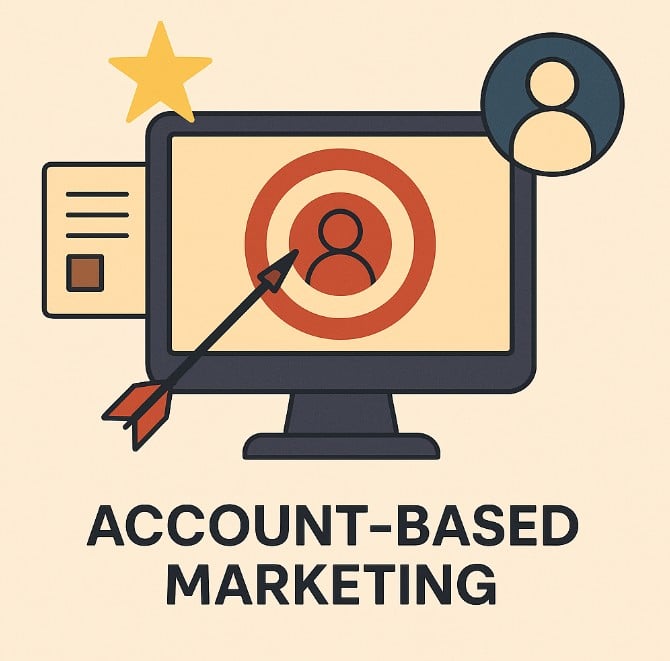Account-based marketing (ABM) can be a powerful instrument in a marketer’s toolbox, but it’s not a magic wand.
Sure. When it’s done right, ABM helps B2B companies focus their marketing and sales efforts on high-value accounts with greater precision and better ROI. But if it goes wrong, it can be a very expensive mistake.
So how can you use ABM to its full potential while avoiding a career-threatening mistake? First, you need to know how ABM can fail. Only then you can fully understand how to ensure it works for you..
Following are the top five reasons ABM can fail, followed by what you can do to avoid it.
-
You’re Targeting the Wrong Accounts
This is probably the most common failure of ABM campaigns. i.e., the campaign has targeted the wrong people. This happens in one of two ways: the net has been cast too wide; or you haven’t effectively researched who your ideal customer actually is. Some teams overreach and build large, unrealistic target lists based on wishful thinking (e.g., big brand logos or “wouldn’t-it-be-cool if” prospects). Chasing these “prospects” wastes valuable time and, therefore, money on targets that would never materialise as customers while simultaneously sucking the oxygen out of those who stand a far better chance of becoming a valuable customer.
Other marketing teams, commit the cardinal sin of skipping the research altogether. Just knowing a company’s industry or size is nowhere near enough. If you haven’t done proper, in-depth research to identify their specific pain points, buying behaviour, or where they are in their decision-making process, you’re just finger-in-the-air guessing.
The fix:
Stay focused. Use intent data to construct your Ideal Customer Profile (ICP) and use that profile to spot which companies are actively looking for solutions like those you provide. Prioritise accounts that show both a strong fit and a clear interest. That way, you know they are looking for you. All you have to do is show them how to find you.
The key is to always remember that a smaller, well-researched list of accounts will outperform a long list of companies that aren’t even in the market you want to attract.
-
Sales and Marketing Aren’t Aligned
If Marketing is targeting one set of accounts and Sales is chasing another, you’re wasting valuable resources and sending mixed messages.
The fix:
Sales and Marketing must build the target account list together. That way, you can set clear, mutually defined goals, decide what success looks like for both parties, and keep communication transparent throughout the campaign’s lifecycle. ABM is a team sport.
-
Personalisation is Superficial or Missing
Conducting outreach in the same way you’ve always done it, i.e., generically, doesn’t work in ABM. If your emails, ads, and landing pages could apply to anyone, you’re completely missing the value of personalisation and ABM.
The fix:
Use what you know about the account—industry challenges, company news, buyer roles—to tailor your content. The whole point of personalisation is to make it personal. Even small personalisation efforts can make prospective customers feel valued and understood.
-
You’re Not Measuring What Matters
Measuring success by leads alone misses the bigger picture in ABM. It’s not just about the number of leads—it’s about engagement, establishing and growing a pipeline, and – surprise, surprise – increasing revenue.
The fix:
The best measurements track a range of metrics that reflect account progress. i.e., the degree of engagement across decision-makers; actual movement, however incremental, through the sales funnel, and the degree of influence a campaign had on closed deals. Establishing measures that set and gauge expected results up front takes time but pays off in higher-value wins. Successful ABM requires it.
-
Your Tech Stack Is Working Against You
If your CRM, marketing automation, or data platforms aren’t set up to support ABM, your efforts will be disconnected and manual.
The fix:
Invest in tools that enable account-level targeting, tracking, and reporting. Even more importantly, make sure your team is trained to use them effectively. A good platform is a solid foundation that can help a great deal—but only if it’s built strong and used correctly.
Final Thoughts
As we said at the beginning, ABM isn’t a quick, magic wand, fix—it’s a strategic, fundamental shift in approach. However, when done well, your Marketing and Sales teams will be in sync, targeting will be vastly improved, and the results will be satisfying.
If your ABM efforts haven’t delivered, examine your processes and, if necessary, fix them. The payoff is worth it.
If you have any questions, please reach out to the team or learn more about our ABM services here!

